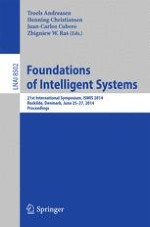This book constitutes the refereed proceedings of the 21st International Symposium on Methodologies for Intelligent Systems, ISMIS 2014, held in Roskilde, Denmark, in June 2014. The 61 revised full papers were carefully reviewed and selected from 111 submissions. The papers are organized in topical sections on complex networks and data stream mining; data mining methods; intelligent systems applications; knowledge representation in databases and systems; textual data analysis and mining; special session: challenges in text mining and semantic information retrieval; special session: warehousing and OLAPing complex, spatial and spatio-temporal data; ISMIS posters.
